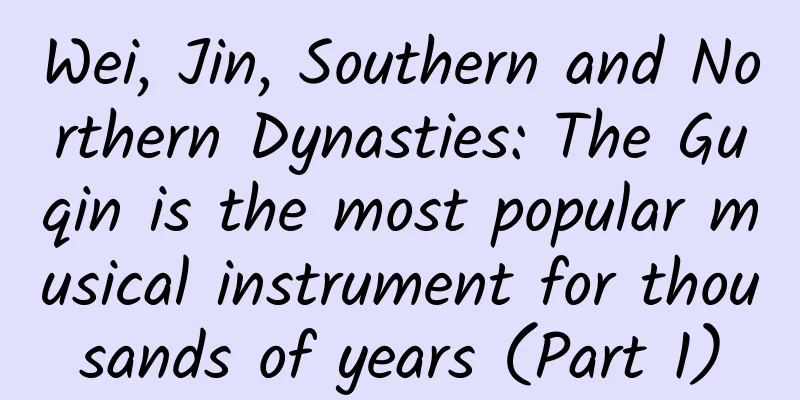Wei, Jin, Southern and Northern Dynasties: The Guqin is the most popular musical instrument for thousands of years (Part 1)

|
Wei, Jin, Southern and Northern Dynasties: The Guqin is the most popular musical instrument for thousands of years (Part 1) Scholars of Lü Zhi Culture Since the art of Guqin was selected as China's second masterpiece of the "Oral and Intangible Cultural Heritage of Humanity" by UNESCO in 2003, a Guqin fever has emerged at home and abroad, and people have begun to realize the importance of Guqin to Chinese music and even Chinese culture. As one of the most widely spread musical instruments in ancient China, Guqin has a very long history of evolution. However, it was not until the Wei, Jin, Southern and Northern Dynasties that it really entered a highly developed stage. The existing Guqin images reveal this glorious journey for us. Wei and Jin Dynasties The earliest existing image of a Wei and Jin guqin is the one painted on a lacquer plate unearthed from Zhu Ran's tomb during the Three Kingdoms period (220-280). Zhu Ran (182-249) was a famous general of the Eastern Wu Dynasty. His courtesy name was Yifeng and he was from Guzhang, Danyang. He was appointed as the Left Grand Marshal and Right Military Advisor and was given the title of Marquis of Dangyang for his repeated military exploits and his fear of the enemy. After his death, Zhu Ran was buried in Yushan Township, Ma'anshan, Anhui Province today. His tomb was discovered by archaeologists in 1984 and is the only tomb of a celebrity whose name can be verified in the "Records of the Three Kingdoms" so far. Most of the artifacts unearthed from the tomb are lacquered wooden objects, totaling about 80 pieces, some of which are beautifully painted. One of them is a lacquer plate with a painting of "Baili Xi meeting his ex-wife". According to Ding Bangjun's "Brief Report on the Excavation of the Tomb of Zhu Ran of the Eastern Wu Dynasty in Ma'anshan, Anhui": "The lacquer plate with the picture of Baili Xi meeting his ex-wife is made of wood, with an open mouth, a shallow belly and a flat bottom. The diameter of the plate is 25.8 cm. The back is painted with black and red lacquer, and the outer wall is painted with cloud patterns. The inner wall is painted with a black and red ground, with creeping grass patterns painted on the edge and cloud patterns painted below. Inward is a circle of red lacquer ground, on which cloud patterns are also painted. The black and red lacquer ground in the middle of the plate depicts the story of Baili Xi and his wife getting back together in old age. There are four people painted on the picture, and three of them have inscriptions next to them. Baili Xi kneels in the middle with his hands raised to his chest, showing a look of surprise. His ex-wife has her back to Baili Xi, playing the zither with her right hand and stroking the strings with her left hand, as if she is playing and singing. Guanhe's wife kneels to the right front of Baili Xi, wiping tears with her left hand. A woman beside her looks at his ex-wife, and seems to be moved by her sad singing." It can be seen that the lacquer plate has an image of the ancient zither from the Three Kingdoms period. Unfortunately, very few images of this lacquer plate have been published, so we cannot get a glimpse of it. We can only imagine the situation through another lacquerware unearthed from Zhu Ran’s tomb - a lacquer plate with a painted picture of the life of the nobility. [Three Kingdoms·Wu] Painted lacquer plate with aristocratic life, unearthed from Zhu Ran’s tomb in Ma’anshan in 1984, collected by Ma’anshan Museum, Anhui Province After the lacquer plate was unearthed from Zhu Ran's tomb, the earliest images of the ancient zither were found in the Western Jin Dynasty brick tomb in Foye Miaowan, Dunhuang. In 1987, in order to cooperate with the maintenance project of Dunhuang Airport, Mr. He Shuangquan of the Gansu Provincial Institute of Cultural Relics and Archaeology presided over the excavation of tombs in the area, among which was a brick tomb with murals from the early to middle period of the Western Jin Dynasty, M133. According to the book "Ancient Mural Tombs" by Luo Shiping and Liao Yang: "The tomb faces east and west, and is a double-chamber brick tomb with double niches and a single-ear chamber. The front chamber has a caisson ceiling with a dome roof, and some of it is painted with lotus flowers. The back wall of the niche on the north wall is painted with curtains, and the north and south ends of the west wall are inlaid with brick paintings of pavilions, barns, and farm life on the manor. A large number of pictures are concentrated on the screen wall at the door of the tomb. After careful planning in advance, various types of imitation wood structure bricks and painted bricks are inlaid. ... The middle of the screen wall is inlaid with painted bricks, with a total of nine layers, four bricks on each layer. Various images are opposite to each other on the left and right... The lower part of the screen wall is an imitation bracket structure, and the layout of the brick paintings in between also maintains the characteristics of left-right symmetry. The themes include red birds, Li Guang turning back and shooting tigers with a bow, parrots, strong men supporting mountains, Boya playing the zither and Ziqi listening to the zither, bear-faced strong men, white tigers, blue dragons, etc. Among them, the stories of Li Guang hunting and Boya and Ziqi are composed of two opposite pictures." [Western Jin Dynasty] Picture brick of Boya playing the zither, unearthed from the Western Jin Dynasty picture brick tomb in Foye Miaowan, Dunhuang in 1987, collected by Jiuquan Museum, Gansu Province It can be seen that there are also images of guqin on the picture bricks unearthed from the Western Jin Dynasty Tomb M133 in Foyemiaowan, Dunhuang, which reflect the story of Boya playing the guqin and Ziqi listening to the guqin. In the autumn of 1997, six ancient tombs of the Jin Dynasty were discovered at the construction site of Nanchang Railway Station in Jiangxi Province. Among them, a wooden block with the date of the eighth year of Yonghe (352) and a bronze mirror with the inscription "Bingwu" (346) were unearthed from Tomb No. 3, which was judged to be an Eastern Jin Dynasty tomb. It is worth noting that a painted banquet lacquer plate with a diameter of 26.1 cm, a bottom diameter of 24.6 cm, and a height of 3.6 cm was unearthed from the tomb. On the vermilion ground of the bottom of the plate, 20 figures were painted in red, yellow, gray, green, black and other colors. In the main position of the picture, there are four old men with long beards sitting on their knees, with a pot-shaped wine container in the middle; the four people are playing the zither, eating, or talking, with a leisurely mood; a waiter on the left introduces a nobleman, who is dressed gorgeously and has a majestic demeanor, and another waiter behind him holds a canopy with a crank. Mr. Sun Ji of the National Museum of China believes that this nobleman is Prince Hui of the early Han Dynasty, and the four old men are the "Four Haos of Shangshan", which is a relatively accurate explanation. Among the "Four Haos", an old man in the upper right corner is playing the zither, which is wide at the head end and narrow at the tail end, slightly in the shape of a long triangle; although only two strings and eight emblems are drawn on the surface of the zither, this is the earliest known image of a zither with zither emblems. [Eastern Jin Dynasty] Painted Banquet Lacquer Plate Excavated from the Nanchang Railway Station Construction Site in 1997 Collection of Nanchang Museum, Jiangxi Province In addition, there is the "Picture of Making Qin" which is said to be painted by Gu Kaizhi (346-407) of the Eastern Jin Dynasty. This picture is now in the collection of the Palace Museum in Beijing. It is on silk, in ink and light colors, 29.4 cm in height and 130 cm in width. There are 14 figures in the picture, showing a series of work processes of making Qin, such as collecting materials, planing boards, making strings, stringing, and listening to the sound. Among them, 9 adults are conductors and workers, 7 sitting and 2 standing, and the seats are covered with tiger skin, dog skin, blankets and other things. The conductors and workers all wear wide robes with large sleeves, behave elegantly, and hold relatively simple production tools. The other 5 figures are servants, all standing, holding objects, holding fans, or carrying cloth bags. This picture is highly realistic. From the picture, you can see that the body of the Qin is relatively long, close to the height of a person, and is made of two hollow wooden boards of the same length, and there are dragon pools and phoenix ponds at the bottom of the Qin. [Eastern Jin Dynasty] Gu Kaizhi, "Picture of Making Qin" (Song Dynasty copy), Collection of the Palace Museum, Beijing This scroll of "Qin Making Picture" is the only ancient painting depicting the process of making guqin so far. It explains the structure and form of guqin in Wei and Jin Dynasties to a certain extent. Although it is not Gu's original work, but a copy from Zhao and Song Dynasties, the animal skins on which the characters sit and the composition form are also similar to the brick-printed mural "Seven Sages of the Bamboo Grove and Rong Qiqi" unearthed from the tomb of the Southern Dynasties in Nanjing. The characters are elegant and handsome, and still have the atmosphere of the Eastern Jin and Southern Dynasties. It can be said that "it is a copy of Gu Kaizhi but still typical". In addition, there are Tibetan seals such as "Xuanhezhong", "Keshi Jingzhong", "Sun Chengze Seal", "Qianlong Yulanzhibao", and "Shiqu Baoji" on the picture, indicating that this picture was probably originally from the Northern Song Dynasty Painting Academy, and it has been circulated since then, so it has a high image historical value. Southern Dynasties In December 1957, a colored brick tomb was discovered in Xuezhuang, Deng County, Henan Province (now Xuezhuang Village, Zhangcun Town, Dengzhou City, Henan Province). Shortly thereafter, the Henan Provincial Archaeological Team excavated the tomb. The tomb has a complex structure and a large shape. It consists of two parts: the tomb chamber and the corridor. The vault, walls and ground are full of specially made relief bricks, such as the bricks with pictures of noble ladies traveling, many of which are colored and still look new when unearthed. Since Deng County was an important frontier town in the early Southern Dynasties, the inscriptions on the bricks with pictures of war horses unearthed in the tomb include the words "The troops have been on the road for a long time,... My home is in Wu County", etc. The academic community has inferred that the age of this tomb is about the Eastern Jin Dynasty or the Song and Qi Dynasties, and no later than the Liang Dynasty. Considering the plane structure, the shape of the painted bricks, and the painting techniques of the tomb, it is slightly earlier than the tomb of the middle period of Liu Song in Xishanqiao, Nanjing and the tomb of the late Xiao Qi Dynasty in Huqiao, Danyang. [Southern Dynasty] "Nanshan Four Hao" portrait brick unearthed in Deng County, Henan Province in 1957, collected by the National Museum of China A brick painting titled "Nanshan Four Haos" was unearthed from the tomb. It is located on the upper part of the rear section of the west wall of the tomb. It depicts the "Nanshan Four Haos" sitting by the water in the mountains and playing music and singing. The one on the right rolls up his sleeves and plays the qin with both hands, the next one plays the sheng, the next one plays the panpipe (or reads a book), and the one on the left raises his head and whistles (or sings a long song). There are also pine trees, phoenix trees, monkeys, phoenixes and other objects painted between the mountains. Lin Shuzhong believes in his book "Six Dynasties Art": "The 'Four Haos' in the ancient Lelang paintings are just figures arranged in order, while the lacquer plate paintings of the Eastern Jin Dynasty (i.e. the painted banquet lacquer plate unearthed from the Eastern Jin Dynasty tomb at Nanchang Railway Station) depict a grand banquet scene and a strong political atmosphere; while the 'Four Haos' on the portrait bricks depict the lofty thoughts of hermits living in the mountains and forests, playing the drums and singing, and 'washing their feet in the Canglang'." The "Four Haos of Nanshan" is a continuation and variation of the painting theme of the "Four Haos of Shangshan". The portrait bricks in Xuezhuang, Deng County are slightly later than the painted banquet and music lacquer plate unearthed from the tomb of the eighth year of Yonghe in the Eastern Jin Dynasty in Nanchang. The image of the guqin presented on the portrait bricks can be roughly determined to be in the early Southern Dynasties. The guqin on the portrait bricks is slightly rectangular, with a slightly wider head and a slightly narrower tail, but the difference is not big. This is quite different from the slightly triangular external shape of the guqin painted on the painted banquet and music lacquer plate. In April 1960, an ancient tomb of the Southern Dynasties was excavated in Xishanqiao, Nanjing. It was a rectangular brick vaulted structure with a tomb passage and two coffin beds in the tomb, which should be a tomb for a couple. The middle part of the left and right walls of the tomb is a brick-printed mural. This kind of brick portrait is the first to be found in the tombs in Nanjing and has a high research value. One of the brick portraits on the left wall is 242.5 cm long and 78 cm high, and it depicts Ji Kang, Ruan Ji, Shan Tao, and Wang Rong from the outside to the inside; the other on the right wall is 241.5 cm long and 78 cm high, and it depicts Xiang Xiu, Liu Ling, Ruan Xian, and Rong Qiqi from the outside to the inside. Therefore, the academic community named these two brick portraits "The Seven Sages of the Bamboo Grove and Rong Qiqi". In the past, it was generally said that this tomb belonged to the Jin and Song dynasties, but according to newer research, the tomb should be in the middle period of the Liu Song Dynasty, and it may be the tomb of Liu Ziye, the former emperor of the Liu Song Dynasty, or the tomb of Liu Yu, the later emperor of the Liu Song Dynasty. More importantly, Ji Kang and Rong Qiqi, two of the eight figures on the brick portrait, are playing the guqin, which provides a more specific and vivid image of the guqin in the Southern Dynasties for future generations. Ji Kang is at the head of the brick painting on the left wall, with his hair in double buns, barefoot, sitting under a ginkgo tree, with a leopard skin mattress, and the guqin placed horizontally on his knees. The shape is different from the various styles of guqin in later generations, but it can be clearly seen that there are 5 strings on the board and more than 10 guqin emblems. Rong Qiqi was a hermit in the Spring and Autumn Period. According to the Biography of Eminent Scholars: "I don't know who Rong Qiqi is. He wears a deer fur coat and a belt, and plays the qin and sings. When Confucius was traveling in Mount Tai, he saw him and asked him about it..." Rong Qiqi, who is painted at the end of the right wall, is sitting cross-legged with a rope tied around his waist, also playing the guqin, which is consistent with the record in the Biography of Eminent Scholars. The shape of the guqin he plays is also different from the guqin of later generations, and it is also different from the one played by Ji Kang. There are five strings on the guqin, and many guqin emblems can be clearly seen outside the strings. [Southern Dynasty] Brick with portraits of the Seven Sages of the Bamboo Grove and Rong Qiqi (rubbings) Unearthed from a Southern Dynasty tomb in Xishanqiao, Nanjing in 1960, now in the collection of Nanjing Museum If you examine it carefully, you will find some common sense errors in the two portrait bricks, such as the placement of the head and tail of the zither is reversed, and the zither player plucks the strings with his left hand and presses them with his right hand, which is also the opposite of the correct way of pressing the strings with the left hand and plucking them with the right hand. However, the historical value of these two portrait bricks is still widely recognized by the zither academic community. Following the bamboo "Seven Sages in the Bamboo Grove and Rong Qiqi" portrait bricks, murals from three large tombs of the Xiao Qi period were discovered in Danyang, Jiangsu Province between 1965 and 1968. These three Xiao Qi tombs all have murals, and the content and subject matter and production techniques are very similar. All of them have molded brick paintings of "Seven Sages in the Bamboo Grove and Rong Qiqi", depicting Ji Kang and Rong Qiqi playing the guqin. In addition to the above three images, the Jinyin Pingwenqin in the Shosoin Repository in Nara, Japan, is also considered by some to be an antique from the Southern Dynasties. For more information about this qin, please refer to my article "The Past and Present Life of the Jinyin Pingwenqin", which will not be elaborated here. |
<<: Sweating profusely while eating... How does diet affect body temperature?
>>: Plants with flowers are not necessarily "flowering plants"
Recommend
When "National Hypertension Day" meets Cold Dew, how can we get through it smoothly?
Author: Liu Machao Department of Cardiology, Xuan...
A must-have for operations, promotion and marketing: a complete list of the latest hot topics in July 2017!
Nowadays, chasing hot topics has become one of th...
Classic "Event Marketing" Cases You Must Know When Operating an App
Topic marketing and event marketing are unfathoma...
Xiaohongshu User Operation Strategy Analysis Report
Xiaohongshu is a representative example. There ar...
Let's have a barbecue on May Day. Let's take a look at some interesting facts about barbecue.
As the weather warms up The barbecue industry is ...
The central bank officially announced that the "digital RMB" will soon appear and "scan" will be eliminated
Preface: In recent years, with the continuous dev...
I have been living with chronic diseases for most of my life
My last name is Zhang, I am 78 years old this yea...
It's rude to be hotter! Is it really normal to be so hot this summer?
I don't know if you have noticed that every y...
How to play the Toutiao project, from account registration, material acquisition to video production and release
How to play the Toutiao account project, from acc...
You treat oyster mushrooms as vegetables, but oyster mushrooms love to eat meat
Produced by: Science Popularization China Author:...
What are the functions of Lanzhou community group buying mini program? How much does it cost to make a group buying mini program?
It has been more than 5 years since the release of...
Reduce costs by 50%, tips for acquiring customers through advertising in children’s programming circle of friends!
In recent years, with the rapid development of ar...
How to sell out the “Flash Group” flash sale?
In most private domain scenarios, if one-on-one c...
Interstellar projectors are coming? Electromagnetic sleds are expected to catapult rare resources to Earth!
There are many scientific facilities, but some of...
Good news for those who love to pick up trash! A 3-cent bottle can be sold for 20 cents here
On October 30, 2023, the United Nations Environme...









